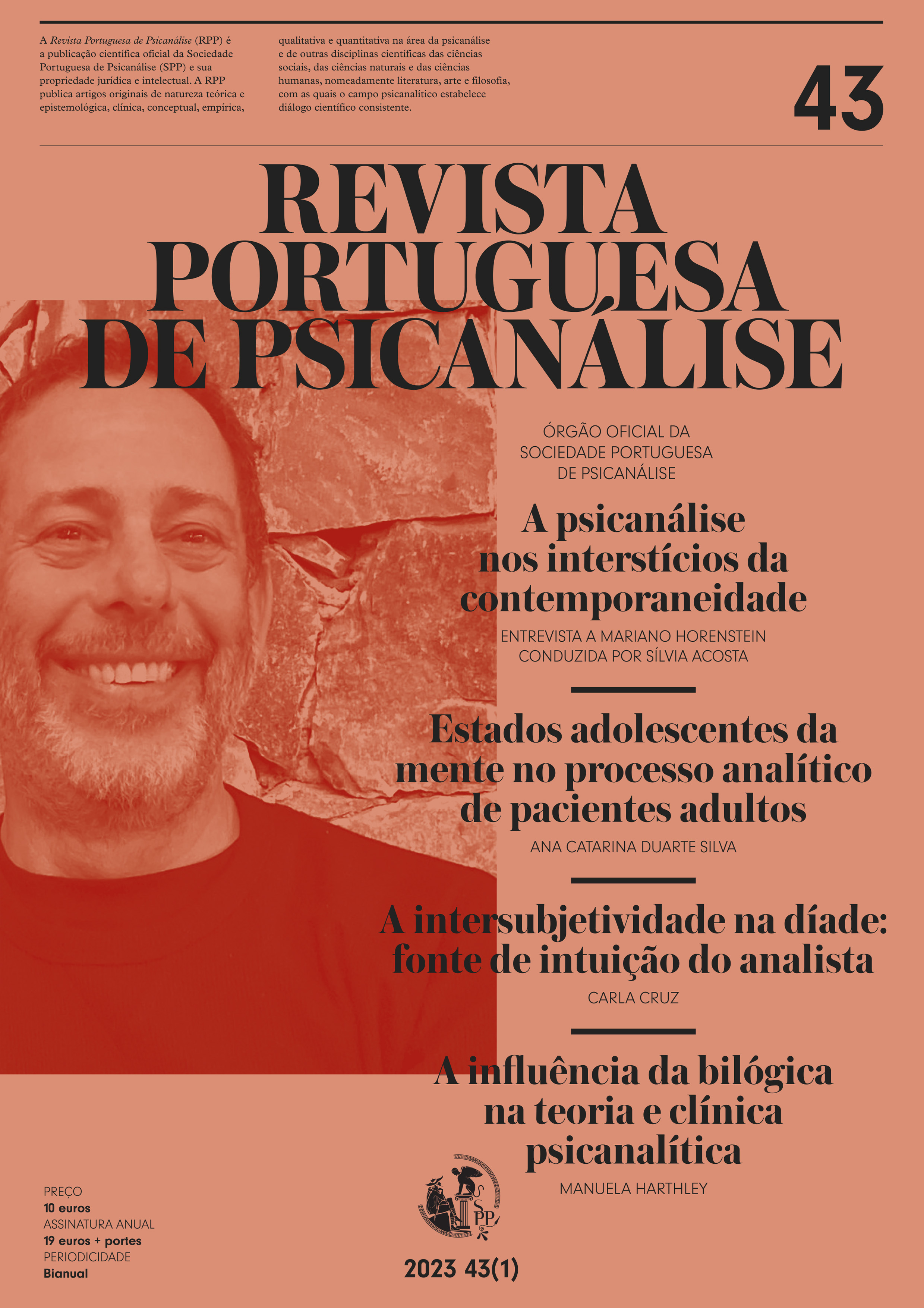Palavra e corpo transcritos no espaço virtual

Résumé
Integrando-se no contexto da situação de pandemia vivida, no presente trabalho propõe-se levar a efeito uma reflexão sobre a possibilidade de, através da escrita, transpor o corpo para a sessão virtual, criando, assim, um objeto transicional. Visando a consecução deste objetivo, a autora tem em conta a importância do impacto causado pela presença do corpo no setting, em particular a do corpo do(da) analista, que se estende ao espaço do seu consultório. Objeto de análise é ainda a natureza do espaço virtual, bem como o modo como a transição do espaço real para o espaço virtual pode interagir com a perceção que temos do corpo, do espaço e do tempo. Prestando particular atenção aos pacientes que sofreram o abandono numa fase precoce da vida e que viveram a separação do espaço físico do consultório como uma reativação dolorosa de antigos e profundos sentimentos de solidão, a autora sugere que o emergir da escrita no decurso da sessão virtual pode aliviar a intensidade da angústia e vitalizar a comunicação da díade terapêutica, ajudando assim a superar as dificuldades decorrentes da separação física imposta.
Biographie de l'auteur
Nadja Tröger
Psicóloga Clínica e da Saúde, psicoterapeuta, psicanalista. Membro associado da Sociedade Portuguesa de Psicanálise (SPP) e da Associação Internacional de Psicanálise (IPA).
Références
- Anzieu, D. (1995). Le Moi – Peau. Dunod. Bleger, J. (1966). Psycho-Analysis of the Psycho-Analytic Frame. The International Journal of Psychoanalysis, 48, 511–519.
- Caper, R. (1997). A mind of one's own. The International Journal of Psychoanalysis, 78, 265–278.
- Canestri, J. (2001). Some Questions on Virtual Reality and Psychoanalysis. In J. Guimón & S. Zac de Filc (Eds.), Challenges of Psychoanalysis in the 21st Century: Psychoanalysis, Health, and Psychosexuality in the Era of Virtual Reality. Springer Science & Business Media.
- Civitarese, G. (2008). The Intimate Room. Theory and Technique of the Analytic Field. Routledge.
- Dini, K. (2009). Internet Interaction: The effects on patient's lives and analytic process. Journal of the American Psychoanalytic Association, 57: 979–988.
- Farber, S. K. (2005). Free Association Reconsidered: The Talking Cure, The Writing Cure. Journal of The American Academy of Psychoanalysis and Dynamic Psychiatry, 33(2), 249–273.
- Figueiredo, L. (2020). A virtualidade do dispositivo de trabalho psicanalítico e o atendimento remoto: uma reflexão em três partes. Cadernos de Psicanálise (CPRJ), 42, 61–80.
- Freud, S. (1912). Ratschläge für den Arzt bei der psychoanalytischen Behandlung. Werke aus den Jahren 1909-1913. Band 8, 375–388. Fischer- Verlag.
- Freud, S. (1919). Das Unheimliche. Werke aus den Jahren 1917–1920. Band 12 (pp. 249–268). Fischer–Verlag.
- Freud, S. (1923). The Ego and The Id. TACD Journal, 17(1), 5–22.
- Fromm-Reichmann, F. (1990). Loneliness. Contemporary Psychoanalysis, 26(2), 305–329. (Original publicado em 1959.)
- Green, A. (2011). Le travail du négatif. Minuit.
- Green, A. (2013). Potential space in psychoanalysis: the object in the setting. In J. Abram (Ed.), Donald Winnicott Today. Routledge. Karavanidou, E. (2017). Is handwriting relevant in the digital era?. Antistasis, 7(1), 153–167. Lemma, A. (2014). The body of the analyst and the analytic setting: Reflections on the embodied setting and the symbiotic transference. The International Journal of Psychoanalysis, 95, 225–244.
- Lemma, A. (2015). Psychoanalysis in times of technoculture: Some reflections on the fate of the body in virtual space. The International Journal of Psychoanalysis, 96, 569–582.
- Lemma, A. (2020). The Aesthetic Link: The Patient's Use of the Analyst's Body and the Body of the Consulting Room. Psychoanalytic Perspectives, 17(1), 57–73.
- Meltzer, D. (1967). The Psychoanalytical Process. William Heinemann.
- Parsons, M. (2008). Raiding the inarticulate: The internal analytic setting and listening beyond countertransference. The International Journal of Psychoanalysis, 88, 1441–1456.
- Quinodoz, J.-M. (2001). A Psychoanalyst: Between an Excess of the Virtual and an Excess of Realism. In J. Guimón & S. Zac de Filc (Eds.), Challenges of Psychoanalysis in the 21st Century: Psychoanalysis, Health, and Psychosexuality in the Era of Virtual Reality. Springer Science & Business Media.
- Segal, H. (1962). The curative factors in psycho–analysis – Contributions to discussion. The International Journal of Psychoanalysis, 43, 212–233.
- Steiner, J. (2006). Interpretative enactments and the analytic setting. The International Journal of Psychoanalysis, 87, 315–320.
- Turkle, S. (1995). Life on the screen: Identity in the age of the internet. Simon & Schuster.
- Turkle, S. (2005). The Second Self: Computers and the Human Spirit. MIT Press.
- Winnicott, D. (2011a). Transitional Objects and Transitional Phenomena. Em L. Caldwell & A. Joyce (Eds.), Reading Winnicott. Routledge.
- Winnicott, D. (2011b). Metapsychological and Clinical Aspects of Regression within the Psycho-Analytical Set-Up. Em L. Caldwell & A. Joyce (Eds.), Reading Winnicott. Routledge.
- Xavier, M. Francisca & Mateus, M. Helena (1990–1992). Dicionário de Termos Linguísticos. Edições Cosmos.